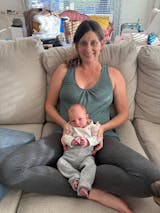Nine Common Myths About Cloth Diapers
Posted by Jason Rector on
Babies are wonderful, but they can create a lot of waste… especially when it comes to diapers. Disposable diapers contribute about 2% to landfill waste. Their plastic material decomposes slowly taking up to 500 years.
Parents know they can help the environment by using cloth diapers. But many refuse to switch. They are confused by myths that tell them cloth diapers are difficult to use and expensive.
This article will dispel those myths so you can make an environmental change today.
What Are the Most Common Myths About Cloth Diapers?
There are many cloth diaper myths floating around the internet. We will do our best to debunk them.

Myth 1: Cloth Diapers Are Expensive
Truth: Cloth diapers may cost more than disposable diapers. But they last for years. You can even use them on multiple children. You will save on repeat purchases and spend less money overall. Statistics show cloth diapers can save parents $1,000 - $2000 over their baby’s time in diapers.
Myth 2: They Are Hard to Use
Truth: Cloth diapers were once hard to use. They came as big squares of cloth that had to be positioned and pinned. But today’s diapers are made for easy changes. Their design is very similar to disposable diapers.
Myth 3: They Cause Diaper Rash
Truth: Cloth diapers are less likely to cause diaper rash than disposable diapers. They aren’t as absorbent so babies will feel when they are wet. They will alert the parents so they get changed sooner. They will have less exposure to wet diapers that cause diaper rash. The diapers are also made of soft, non-irritating materials.
Myth 4: They Reduce Sperm Count in Boys
Truth: Boys do not produce sperm until after puberty. So diapers can't affect sperm count. Diapers should be applied with the boy’s penis facing down. But no matter how you put them on, they won’t affect your child’s reproductive health.

Myth 5: They Are Not Environmentally Friendly
Truth: Some parents feel cloth diapers aren’t environmentally friendly because they must be washed. Washing machines use energy and water that deplete the environment. However, many modern washers and dryers are energy-efficient. An ENERGY STAR washer uses about 35% less energy than a standard washer. Their dryers use 20% less energy than traditional models.
Myth 6: Daycares Won’t Let Parents Use Cloth Diapers
Truth: Some daycares are hesitant to use cloth diapers. However, parents can make the process daycare-friendly by providing one-step diapers, wet bags, and expert advice. If the daycare has a strict ‘no cloth diaper’ policy, you can still use them at home.
Myth 7: They Leak
Truth: Yes, cloth diapers can leak. But all diapers leak. The trick to a non-leaky baby involves using diapers that fit properly and are applied correctly. The material has little to do with it.
Myth 8: You Can’t Wash Cloth Diapers with Mainstream Detergent
Truth: You can use any type of detergent on a cloth diaper. However, it’s best to stay away from detergents with fabric softener which can coat the fabric. If your baby has sensitive skin, you may have to use a special detergent. But parents of babies with sensitive skin are likely to use a special detergent anyway.
Myth 9: Cloth Diapers Make It Hard to Do Laundry
Truth: Cloth diapers may result in extra loads of laundry. But they will also cut down on trips to buy diapers. The laundry process is easy. Simply prewash the diapers and add them to a hot cycle with detergent.
How Can I Be Successful with Cloth Diapers?
Cloth diapers can be difficult for new parents to manage. But with the right tips, you’ll get the hang of them soon enough. Here are some to keep in mind:

Use Pre-folds
Pre-fold diapers are a recommended choice. They are absorbent and easy to clean. You can also use them for other purposes. For example, they make great bibs, burp rags, mattress pads, and breast pads.
Skip the Fabric Softener and Dryer Sheets
Fabric softener and dryer sheets will coat the diaper and cause it to repel liquids. It can cause detergent and ammonia buildup. For the best results, leave them out of your wash.
Use Wet Bags
Wet bags are used to store dirty cloth diapers when you are out and about.
Use Safe Diaper Cream
Diaper creams with zinc will stain your cloth diapers. Creams with petroleum will coat the diapers so they repel liquids. Look for safe, natural diaper creams that do not contain these ingredients.
Try Different Styles
Many parents get turned off by the cloth diaper experience because they don’t use a style that works for them. Some parents may prefer all-in-ones over pre-folds that have multiple pieces. Experiment to find a style that’s suited to your lifestyle.
Get the Fit Right
Learn how to put a cloth diaper on your child to ensure a proper fit. Adjust the rise snaps first and the waist snaps second. This method will reduce bulk and prevent leaks.
Follow a Simple Wash Routine
Follow these steps to keep your wash routine simple:
- Prewash on warm with a small amount of detergent.
- Put the diaper in the wash on a heavy-duty cycle with hot water
- Rinse
Find the Right Brand
It’s essential to use a cloth diaper brand you can trust. The brand should use organic, all-natural materials, and create easy-to-use designs. Babee Greens is a recommended choice.
Babee Greens uses all-natural materials that are soft on a baby’s skin. Our one-size-fits-all fitted cloth will fit babies 5-35 pounds. We offer a variety of products including starter kits that make the transition to cloth easy.
Browse our website to find out more about our high-quality products. Contact us with any questions you may have. We are here to help you achieve a terrific parenting experience.
Share this post
- Tags: cloth diapers

